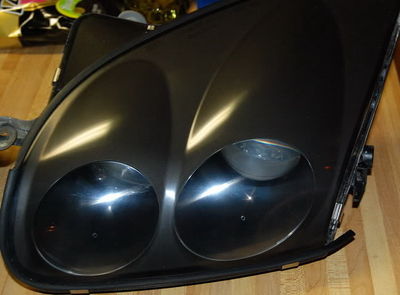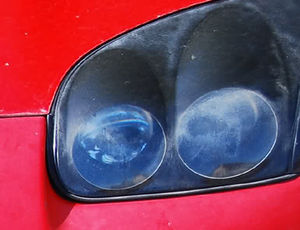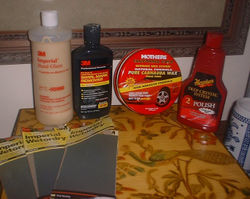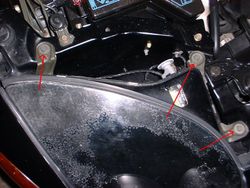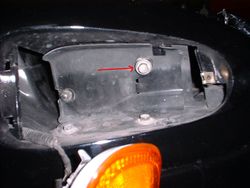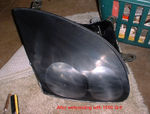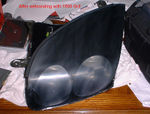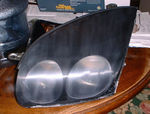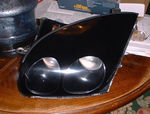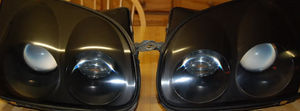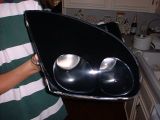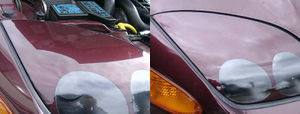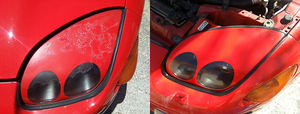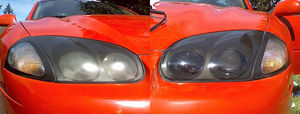Lights: Clean and Restore Plastic-Lexan Headlights
Do your headlights look as though they've developed a nasty sunburn or milky surface condition? Is your Dodge Stealth or Mitsubishi 3000GT a 1995 or above? If this sounds like you, there's a good chance you have plastic/lexan headlights, and your protective clear coat is shot. This is one of the most common exterior issues that 1995-1996 Dodge Stealth and 1995-1999 Mitsubishi 3000GT owners face. Unlike the glass headlights offered in 1994, the lexan covers are prone to a particular hazing, peeling, fogging, yellowing and/or oxidation that can noticeably be seen and felt on the surface of the headlight. What was once a perfectly clear, smooth lens when our cars were new has eventually given way to a crusty, flakey or clouded appearance that may seem nearly impossible to remove.
However, worry not. What now looks old can become new again! Depending on the material of your headlight cover, there are two differing methods owners can take to remedy this problem with the most basic of materials.
Determining Glass or Plastic/Lexan[edit]
| 1994 (All) | Glass Projector Headlights |
|---|---|
| 1995-1996 (Stealth) | Plastic/Lexan Projector Headlights (*) |
| 1995-1999 (3000GT/GTO) | Plastic/Lexan Projector Headlights (*) |
Note (*): Some early 1995 model Mitsubishi 3000GT/GTO's and Dodge Stealth's reportedly came with glass headlights
Before proceeding, you will need to determine if your headlight covers are made of glass or plastic/lexan. All 1994 Mitsubishi 3000GT/GTO and Dodge Stealth owners can assume their covers are glass (unless they've been replaced by a previous owner), while most 1995 and above owners will find their headlight covers are plastic/lexan. There have been some reported crossover between 1994-1995 as leftover headlights from 1994 may have been used on 1995 year vehicles. When in doubt, you can gently tap on the surface to get a pretty good idea on if they feel like glass or plastic. If they're glass, check How to Clean Your Mitsubishi 3000GT/GTO or Dodge Stealth Glass Headlights. If they're plastic, you're in the right place right here.
Restore Plastic/Lexan Headlights on a 1995+ Mitsubishi 3000GT/GTO and Dodge Stealth[edit]
Plastic/lexan headlights that are in need of a good cleaning/restoration are pretty easy to spot. Chances are they'll look close to the image to the right, with a flaked, scratched or white-encrusted surface. All plastic/lexanheadlights are prone to this ultimate fate, and can be the result of years of putting up with nature's wrath, including harsh sunlight and being exposed to the elements. Over time, the clear, protective coating on these headlights seperate from the plastic, resulting in the tattered appearance that they have now. In order to fix this, you must reverse the damage by removing the old clear coat, and then re-apply a new protective coat in its place.
Materials Required[edit]
In order to prepare, you will need the proper restoration materials. There's two paths you can take: assemble your own kit (~$25 - $30), or buy a pre-made kit offered by Turtle Wax or 3M (~$15 - $20). Most headlight restoration kits include all of the same materials and promise similar results, but you might have some of these items sitting around your detailing kit already. Both options are presented.
Option #1: Build-Your-Own Headlight Restoration Kit
- Bowl of water
- 3M Sandpaper (3-styles)
- 1000 Grit
- 1500 Grit
- 2000 Grit
- 3M Imperial Hand Glaze (#05990)
- 3M Professional Swirl Mark Remover (optional)
- Maguire's Polish
- Mothers California Gold Pure Carnauba Wax
Option #2: Pre-bundled Headlight Restoration Kits
- 3M's Headlight Restoration Kit
- Turtle Wax Headlight Lens Restorer Kit
- Micro-Surface.com Headlight Restoration Kit
Tools Required[edit]
- Phillips screwdriver
- Socket wrench
- 10mm socket
- Terry cloth(s) / Microfiber cloth(s)
- Orbital buffer (optional)
- 3M Hand Sanding Block (optional)
Remove Headlights[edit]
- Unbolt the top three bolts holding the headlights to the car. Upon opening the hood, you will see and need to unscrew the three visible bolts holding each headlight in place.
- Remove turn signals/side markers. Each headlight has one hidden bolt behind the turn signal. Unscrew the single screw holding the turn signals in place, and remove the turn signal by sliding it towards the front of the car. Be aware/cautious of the two prongs on the back of the turn signal to keep them from scratching your paint. You do not need to disconnect the signal's wiring harness.
- Unbolt the one remaining headlight bolt. The bolt can be found behind where the turn signal used to be.
- Detach the headlights from their wire harnesses and remove them from the car.
Wet Sand the Headlights[edit]
The sanding portion is arguably the most strenuous part of restoring your headlights. It takes a lot of rubbing, and your arm should feel like it's about to fall off by the time you're done. Take extra care during this step, as this is what'll ultimately remove the existing flaking/grime that sits on top of your headlight covers.
- Prepare a bowl of clean water.
- Attach the 1000 grit sandpaper to the hand sanding block. While the hand sanding block is optional, it does make the process a lot easier.
- Dip the sanding paper into the bowl of water and begin sanding the headlight. The surface of the headlights will turn white while sanding, and may even start looking worse (don't worry, this is expected). Keep sanding until the color is consistant. Any discolored areas means there is still clear coat left. Be sure to continuously dip the sandpaper back into the water to keep it wet. The more blemishes you remove with the 1000 grit sandpaper, the easier the following steps will be.
- Repeat the process with 1500 grit sandpaper. Sand everything in one direction, and be sure to give special attention to any scratched areas on your headlights to smooth them out. Once the color of the surface of your headlights is consistant once again, proceed to the next step.
- Repeat the process with 2000 grit sandpaper. Continue dipping the sandpaper in water and then sanding the surface of the headlight. Once the surface color is consistant and you feel you have sanded out the imperfections, it's time to start making them shiny again.
Apply Hand Glaze and Swirl Remover[edit]
- Apply the 3M Imperial Hand Glaze to a clean terry cloth.
- Rub the glaze onto the headlight in a circular motion. Rub for about a minute or two, and then use another clean cloth to wipe off the residue. It may take a few additional applications of the hand glaze to remove all of the haze. Continue this step until your headlight looks like this:
- Apply the 3M Swirl Remover to the orbital buffer (optional). The necessity of this step is debatable, but may help remove any final imperfections that the wet sanding didn't take care of.
- Buff the surface of the headlight using the swirl remover (optional). Run the orbital buffer over the complete surface of the headlight. You will notice the lens will start becoming hazy again.
- Re-apply the 3M Imperial Hand Glaze. Just like you did after the wet sanding, use the hand glaze to remove the haze from the surface of the headlight until all of the haze is gone.
Apply Polish and Carnauba Wax[edit]
- Apply the Meguire's Polish to a clean terry cloth.
- Rub the polish onto the headlight in a circular motion. You will begin to see real shine start to come back to your headlights. After applying one coat of polish, you may wish to apply another coat of Hand Glaze (which is optional, but may further help clean them up).
- Apply the Mothers California Gold Pure Carnauba Wax to the headlight. The wax is used to help protect the headlight lens from future damage. Apply several layers, and remove any excess with a clean microfiber cloth.
Enjoy your brand new looking lexan headlights!
